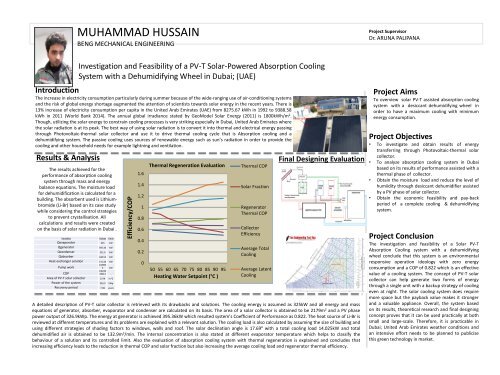UWE Bristol Engineering showcase 2015
Create successful ePaper yourself
Turn your PDF publications into a flip-book with our unique Google optimized e-Paper software.
Yiap Mun Lu<br />
Mechanical <strong>Engineering</strong><br />
Project Supervisor<br />
Mr Patrick O’Flynn<br />
Zero Carbon Hospitality Pods: Solar Water Heating<br />
The evacuated tube collector offers a means of providing high<br />
temperature operation with high efficiency. Thermosyphon systems work<br />
because of natural convection. Water flows through the system when<br />
warm water rises because they are lighter as cooler water sinks due it<br />
being heavier. The collector must be installed below the storage tank so<br />
that warm water will rise into the tank. No pumps or motors are involved<br />
in these systems.<br />
The ultimate development of solar energy totally depends on how the technicality and<br />
scientific problems are approached and solved not to mention the economic and<br />
political aspect of it. 82% of the energy used in households is for space or water<br />
heating. Less than a third of all housing stock in Great Britain had central heating in<br />
1970. Thirty years later, the proportion had risen to 89%. Within the zero carbon<br />
hierarchy, minimum levels of energy efficiency for the building envelope will be<br />
required. At present Code level 6 requires a heat loss parameter of 0.8 W/m2 K to be<br />
achieved, which is comparable to the building fabric and airtightness requirement of<br />
the PassivHaus standard [10]. To achieve the current standard, excellent U-values for<br />
all of the fabric elements, levels of airtightness<br />
Project summary<br />
The UK government is committed to sustainable<br />
growth and the green agenda. This is demonstrated<br />
through various legally binding targets and standards,<br />
from which the Climate Change Act 2008 (CCA) is<br />
considered one of the most important. The Act<br />
mandates an 80% reduction in CO2 from the 1990<br />
levels, which are used as a baseline, by 2050[1]<br />
Project Objectives<br />
The ultimate aim of this investigation is to<br />
develop a zero carbon energy concept for<br />
water heating in hospitality pods. The<br />
investigation involves an in-depth study and<br />
analysis of the most common ways of solar<br />
water heating applications. The regulations<br />
for zero carbon buildings and the parameters<br />
also must be studied in order to present an<br />
acceptable concept. While considering<br />
hospitability pods, the proposed concept<br />
must be suitable for a temporary<br />
accommodation.<br />
Project Conclusion<br />
Thermosyphon phenomena combined with evacuated<br />
solar thermal collectors design has proven to be more<br />
efficient and appropriate for the problem.


